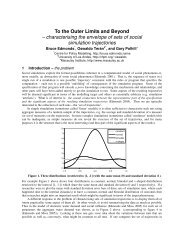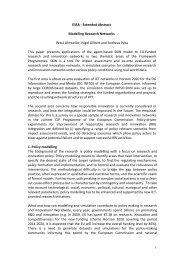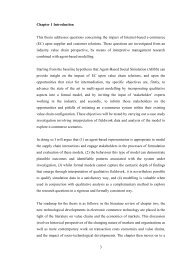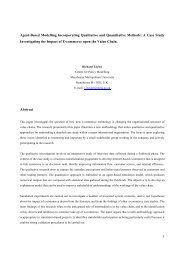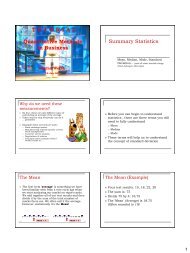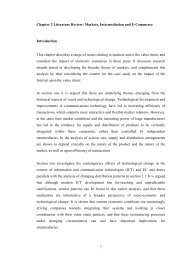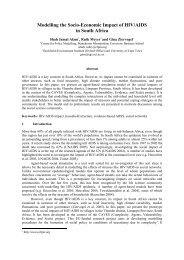222 Chapter 8 Discussion Introduction This chapter reflects on the ...
222 Chapter 8 Discussion Introduction This chapter reflects on the ...
222 Chapter 8 Discussion Introduction This chapter reflects on the ...
You also want an ePaper? Increase the reach of your titles
YUMPU automatically turns print PDFs into web optimized ePapers that Google loves.
<str<strong>on</strong>g>Chapter</str<strong>on</strong>g> 8 <str<strong>on</strong>g>Discussi<strong>on</strong></str<strong>on</strong>g><br />
<str<strong>on</strong>g>Introducti<strong>on</strong></str<strong>on</strong>g><br />
<str<strong>on</strong>g>This</str<strong>on</strong>g> <str<strong>on</strong>g>chapter</str<strong>on</strong>g> <str<strong>on</strong>g>reflects</str<strong>on</strong>g> <strong>on</strong> <strong>the</strong> main findings of <strong>the</strong> research in terms of its c<strong>on</strong>tributi<strong>on</strong>s<br />
to: <strong>the</strong> key issues of <strong>the</strong> case study, questi<strong>on</strong>s raised in <strong>the</strong> e-commerce literature, <strong>the</strong><br />
methodology of agent-based modelling applied to <strong>the</strong>se issues, and <strong>the</strong> stakeholder /<br />
participatory approach. The latter two are very important aspects of <strong>the</strong> c<strong>on</strong>tributi<strong>on</strong><br />
to knowledge because <strong>the</strong>y are an original combinati<strong>on</strong> in methodological approach,<br />
and so <strong>the</strong>y shall be <strong>the</strong> focus of attenti<strong>on</strong> in this <str<strong>on</strong>g>chapter</str<strong>on</strong>g>.<br />
Secti<strong>on</strong> <strong>on</strong>e returns to <strong>the</strong> discussi<strong>on</strong> of stakeholder participati<strong>on</strong> which was presented<br />
in <str<strong>on</strong>g>chapter</str<strong>on</strong>g> six, and extends it to c<strong>on</strong>sider in fur<strong>the</strong>r detail <strong>the</strong> problems with lack of<br />
feedback and access to <strong>the</strong> organisati<strong>on</strong>. Secti<strong>on</strong> two c<strong>on</strong>siders <strong>the</strong> extent to which <strong>the</strong><br />
objectives of <strong>the</strong> participatory aspect of <strong>the</strong> case study were attained, and <str<strong>on</strong>g>reflects</str<strong>on</strong>g><br />
up<strong>on</strong> <strong>the</strong> experience of collaborating with industry by c<strong>on</strong>sidering <strong>the</strong> usability of <strong>the</strong><br />
approach. It also develops some pers<strong>on</strong>al views <strong>on</strong> how <strong>the</strong> research progressed and<br />
what was learnt from <strong>the</strong> experience. Secti<strong>on</strong> three compares three alternative<br />
approaches to participatory enquiry, and draws some additi<strong>on</strong>al less<strong>on</strong>s from this<br />
literature.<br />
Secti<strong>on</strong> four <str<strong>on</strong>g>reflects</str<strong>on</strong>g> <strong>on</strong> <strong>the</strong> main findings of <strong>the</strong> research, by revisiting <strong>the</strong> original<br />
research hypo<strong>the</strong>ses, and c<strong>on</strong>sidering how <strong>the</strong> case study has developed<br />
understanding in <strong>the</strong>se areas. The findings are placed in <strong>the</strong> c<strong>on</strong>text of <strong>the</strong> earlier<br />
literature about <strong>the</strong> impact of e-commerce, and are used to make some observati<strong>on</strong>s<br />
<strong>on</strong> <strong>the</strong> key <strong>the</strong>mes of intermediati<strong>on</strong>, value chain relati<strong>on</strong>s, and <strong>the</strong> integrati<strong>on</strong> of e-<br />
commerce systems. In particular <strong>the</strong> secti<strong>on</strong> looks at <strong>the</strong> issue of how to attain a<br />
widespread use from <strong>the</strong> perspective of <strong>the</strong> multinati<strong>on</strong>al. The c<strong>on</strong>tributi<strong>on</strong> to <strong>the</strong>se<br />
debates is elucidated, in view of <strong>the</strong> extent to which <strong>the</strong> case study findings can be<br />
generalised.<br />
<str<strong>on</strong>g>222</str<strong>on</strong>g>
Secti<strong>on</strong> five presents a critique of <strong>the</strong> <strong>the</strong>sis, focusing up<strong>on</strong> <strong>the</strong> related issues of lack<br />
of data and <strong>the</strong> ra<strong>the</strong>r singular perspective of <strong>the</strong> research. Finally, secti<strong>on</strong> six<br />
suggests some avenues for fur<strong>the</strong>r research.<br />
223
8.1 Reflecti<strong>on</strong> <strong>on</strong> <strong>the</strong> Stakeholder Participati<strong>on</strong><br />
<str<strong>on</strong>g>This</str<strong>on</strong>g> secti<strong>on</strong> <str<strong>on</strong>g>reflects</str<strong>on</strong>g> <strong>on</strong> <strong>the</strong> outcomes of <strong>the</strong> stakeholder involvement, and positi<strong>on</strong>s<br />
<strong>the</strong> c<strong>on</strong>tributi<strong>on</strong> to knowledge of this research in terms of participatory methodology.<br />
As stated previously in secti<strong>on</strong> 6.1, <strong>the</strong> stakeholders were very important to<br />
undertaking <strong>the</strong> project as <strong>the</strong>y were involved in several key phases. To summarise<br />
<strong>the</strong> research experiences described in that secti<strong>on</strong>, it was c<strong>on</strong>cluded that:<br />
• Viability depends up<strong>on</strong> <strong>the</strong> interest of small number of people<br />
• Obtaining required access to <strong>the</strong>se people can be problematic<br />
• Changing circumstances can curtail <strong>the</strong> research<br />
The first of <strong>the</strong>se points signifies that it may be difficult to get an initial ‘foot in <strong>the</strong><br />
door’ of <strong>the</strong> organisati<strong>on</strong>. It illustrates <strong>the</strong> principle, described by Hammersley and<br />
Atkins<strong>on</strong> (1983, pg. 60), of informal ‘sp<strong>on</strong>sorship’ that serves to validate <strong>the</strong> presence<br />
of <strong>the</strong> researcher and pave <strong>the</strong> way for access. Fur<strong>the</strong>rmore, as in this case study, <strong>the</strong><br />
sp<strong>on</strong>soring individual(s) are likely to be willing to fulfil <strong>the</strong> stakeholder role.<br />
The sec<strong>on</strong>d point signifies that <strong>the</strong>re may be limited access to those pers<strong>on</strong>s and also<br />
to <strong>the</strong> organisati<strong>on</strong>. The nature of <strong>the</strong> relati<strong>on</strong>ship with <strong>the</strong> sp<strong>on</strong>sor / stakeholder will<br />
shape <strong>the</strong> development of <strong>the</strong> research in that it can facilitate some kinds of access<br />
(for example, to <strong>the</strong> company’s sales data) and obstruct o<strong>the</strong>rs (for example, to<br />
knowledge about <strong>the</strong> customers of <strong>the</strong> company). From <strong>the</strong> third point it should be<br />
recognised that access negotiati<strong>on</strong>s are <strong>on</strong>going and changeable, as explained by<br />
Hammersley and Atkins<strong>on</strong> <strong>on</strong> <strong>the</strong>ir <str<strong>on</strong>g>chapter</str<strong>on</strong>g> <strong>on</strong> access in ethnographic research:<br />
“The problem of access is not resolved <strong>on</strong>ce <strong>on</strong>e has gained access to a setting, since<br />
this by no means guarantees access to all <strong>the</strong> data available within it … negotiati<strong>on</strong><br />
of access is <strong>the</strong>refore likely to be a recurrent preoccupati<strong>on</strong>”. (Hammersley and<br />
Atkins<strong>on</strong> 1983, pg. 76)<br />
224
One aspect of organisati<strong>on</strong>al access that was particularly problematic was that of<br />
access to feedback from <strong>the</strong> stakeholders. There are three reas<strong>on</strong>s that can be put<br />
forward to explain <strong>the</strong> lack of feedback in this case study.<br />
Firstly, <strong>the</strong>re was a tendency to get sidetracked during <strong>the</strong>se meetings. In particular, I<br />
felt that we spent too much time discussing <strong>the</strong> breadth of what could be included in<br />
<strong>the</strong> investigati<strong>on</strong> ra<strong>the</strong>r than focusing <strong>on</strong> getting results from a small study, which<br />
may have been a more productive use of <strong>the</strong> available time. Though very interesting,<br />
<strong>the</strong> meetings failed to c<strong>on</strong>verge up<strong>on</strong> <strong>the</strong> practical c<strong>on</strong>siderati<strong>on</strong>s that likely would<br />
have led to a more complete research investigati<strong>on</strong>. <str<strong>on</strong>g>This</str<strong>on</strong>g> has implicati<strong>on</strong>s for <strong>the</strong><br />
c<strong>on</strong>clusi<strong>on</strong>s we can draw from <strong>the</strong> study (see secti<strong>on</strong> 8.5).<br />
Without a doubt, it is easy to find <strong>on</strong>eself swapping ideas and stories and trying to<br />
make sense of a multifaceted, emerging technology like e-commerce, and I must<br />
accept resp<strong>on</strong>sibility for allowing c<strong>on</strong>versati<strong>on</strong> to drift from topic to topic. It was<br />
interesting for me to hear about <strong>the</strong> practical problems and perspectives of those<br />
involved in setting up <strong>the</strong>se systems, and to see how this sat with <strong>the</strong> literature<br />
produced. The stakeholders were very f<strong>on</strong>d of exchanging anecdotes and stories about<br />
<strong>the</strong>ir experiences, but were also interested to hear <strong>the</strong> latest academic views, which<br />
were often outside <strong>the</strong> scope of <strong>the</strong>ir learning material and sources of background<br />
informati<strong>on</strong>.<br />
Setting aside <strong>the</strong>se fertile discussi<strong>on</strong>s, in order to make good progress with <strong>the</strong><br />
research <strong>the</strong>se experiences suggest that setting goals for each meeting would be<br />
beneficial. Also <strong>the</strong> researcher must if possible take <strong>the</strong> initiative and set <strong>the</strong> agenda<br />
for <strong>the</strong> meeting, in order to make sure those goals are attained.<br />
The sec<strong>on</strong>d reas<strong>on</strong> to explain <strong>the</strong> difficulty of obtaining feedback is that <strong>the</strong>re were<br />
often l<strong>on</strong>g lengths of time between meetings. The stakeholders, and myself, would<br />
sometimes forget what had been previously discussed. It is very important in<br />
participatory projects that every<strong>on</strong>e knows what <strong>the</strong> o<strong>the</strong>rs are doing, and what <strong>the</strong>y<br />
have agreed to do <strong>the</strong>mselves. In c<strong>on</strong>trast to many empirical methods such as<br />
interviews or surveys, in participatory projects <strong>the</strong> ‘subjects’ of <strong>the</strong> research are<br />
<strong>the</strong>mselves part of <strong>the</strong> research team.<br />
225
It was perhaps unavoidable that <strong>the</strong>re are large gaps of time. Lack of man-hours to <strong>the</strong><br />
project meant that progress was quite slow and a l<strong>on</strong>g time had passed between <strong>the</strong><br />
data collecti<strong>on</strong> and <strong>the</strong> point where <strong>the</strong> first results were available (a period of 9<br />
m<strong>on</strong>ths) for example. During this time I did provide a report <strong>on</strong> <strong>the</strong> fieldwork analysis<br />
– a partial first draft of <str<strong>on</strong>g>chapter</str<strong>on</strong>g> five of this <strong>the</strong>sis. However, <strong>the</strong> stakeholders perhaps<br />
felt that <strong>the</strong>y did not know what I was doing during <strong>the</strong>se times. <str<strong>on</strong>g>This</str<strong>on</strong>g> was a comment<br />
dropped by <strong>on</strong>e of <strong>the</strong>m before our final meeting, and I suspect it to be partly a result<br />
of <strong>the</strong>se relatively large time gaps. If <strong>the</strong>re were a regular communicati<strong>on</strong> between<br />
participants, <strong>the</strong>n this problem (of lack of face-to-face c<strong>on</strong>tact) would be alleviated, to<br />
some extent. <str<strong>on</strong>g>This</str<strong>on</strong>g> is important because large gaps in time are likely to increase <strong>the</strong><br />
danger that <strong>the</strong> participants interests in <strong>the</strong> project will diminish.<br />
Thirdly, and finally, <strong>the</strong> largest reas<strong>on</strong> for poor feedback was <strong>the</strong> increasing lack of<br />
involvement of <strong>the</strong> stakeholders because of <strong>the</strong>ir time c<strong>on</strong>straints. My research<br />
logbook shows several cancelled or rescheduled meetings and lower e-mail and<br />
teleph<strong>on</strong>e resp<strong>on</strong>se. In my opini<strong>on</strong>, this was clearly <strong>the</strong> most important reas<strong>on</strong> for <strong>the</strong><br />
lack of feedback. On more than <strong>on</strong>e occasi<strong>on</strong>, <strong>the</strong> stakeholders <strong>the</strong>mselves said that<br />
<strong>the</strong>ir own time c<strong>on</strong>straints were <strong>the</strong> main factor in <strong>the</strong>ir lack of involvement, adding<br />
that <strong>the</strong>y were regretful of this situati<strong>on</strong>.<br />
They did evaluate <strong>the</strong> model, and provide feedback in a limited sense, which was less<br />
than had been expected. We tested <strong>the</strong> model by discussing <strong>the</strong> list of drivers and<br />
inhibitors of Internet e-commerce that were based <strong>on</strong> <strong>the</strong> fieldwork findings, and by<br />
discussing <strong>the</strong> endorsements model that was being developed. We also looked at<br />
some of <strong>the</strong> preliminary results, <strong>on</strong>ce <strong>the</strong> model was working, but this was quite brief.<br />
Most of <strong>the</strong> time was spent discussing <strong>the</strong> assumpti<strong>on</strong>s of <strong>the</strong> model, which was in<br />
fact more appropriate at that stage of development (see secti<strong>on</strong> 6.6).<br />
Given that <strong>on</strong>e feature of participatory enquiry is <strong>the</strong> likelihood of access problems<br />
menti<strong>on</strong>ed earlier, and given <strong>the</strong> discussi<strong>on</strong> of <strong>the</strong> problems of achieving feedback<br />
issues, <strong>on</strong>e final principle would recognise <strong>the</strong> imperative to take all opportunities<br />
available to proceed with <strong>the</strong> work to a satisfactory c<strong>on</strong>clusi<strong>on</strong>.<br />
226
The next secti<strong>on</strong> c<strong>on</strong>siders what was achieved by <strong>the</strong> research approach, in terms of<br />
informing <strong>the</strong> stakeholders and bringing insight to <strong>the</strong>ir understanding of some<br />
aspects of <strong>the</strong> business.<br />
8.2 Reflecti<strong>on</strong> up<strong>on</strong> <strong>the</strong> Usability of <strong>the</strong> Approach<br />
One of <strong>the</strong> objectives was for <strong>the</strong> research to produce some findings that would be<br />
useful to <strong>the</strong> stakeholders. <str<strong>on</strong>g>This</str<strong>on</strong>g> secti<strong>on</strong> <str<strong>on</strong>g>reflects</str<strong>on</strong>g> up<strong>on</strong> <strong>the</strong> questi<strong>on</strong> of how well <strong>the</strong><br />
approach did what it was hoped in <str<strong>on</strong>g>chapter</str<strong>on</strong>g> four - what exactly it achieved in terms of<br />
helping <strong>the</strong> stakeholders. Bearing in mind here what was discussed in 8.1, i.e. <strong>the</strong> lack<br />
of involvement <strong>on</strong> <strong>the</strong> part of <strong>the</strong> stakeholders, it is difficult to answer this questi<strong>on</strong>.<br />
As stated earlier, I did set out to inform stakeholders <strong>on</strong> <strong>the</strong> benefits and opportunities<br />
associated with <strong>the</strong> development of e-commerce. However, this was found to be<br />
difficult in practice, as result of <strong>the</strong> lack of access. <str<strong>on</strong>g>This</str<strong>on</strong>g> became increasingly a<br />
problem after late 2002 whilst <strong>the</strong> model was still under development and <strong>the</strong><br />
experiments had not yet been carried out.<br />
The results from <strong>the</strong> prototype experiments that were taken back to <strong>the</strong> company<br />
inspired <strong>the</strong> stakeholders to ask questi<strong>on</strong>s and pursue <strong>the</strong> introducti<strong>on</strong> of fur<strong>the</strong>r<br />
studies (i.e. surveys), which is an indicati<strong>on</strong> of <strong>the</strong>ir interest and <strong>the</strong> fact that <strong>the</strong>y<br />
value <strong>the</strong> potential of this kind of work to highlight customer relati<strong>on</strong>ship and internal<br />
efficiency shortcomings. In additi<strong>on</strong>, <strong>the</strong>y could see how it could lead to MAS<br />
applicati<strong>on</strong>s, for example <strong>the</strong>y were interested in <strong>the</strong> development of software<br />
systems for managing and analysing <strong>the</strong>ir e-commerce data. <str<strong>on</strong>g>This</str<strong>on</strong>g> kind of research and<br />
its applicati<strong>on</strong>s was seen by <strong>the</strong> stakeholders as something which could give <strong>the</strong>m an<br />
advantage in terms of expertise in e-commerce, which was something c<strong>on</strong>sidered very<br />
important within <strong>the</strong> strategic planning of <strong>the</strong> company.<br />
To clarify, <strong>the</strong> situati<strong>on</strong> was that <strong>the</strong> research approach was seen as showing str<strong>on</strong>g<br />
potential to be useful to <strong>the</strong> stakeholders, and indeed it did produce some interesting<br />
findings (see later secti<strong>on</strong> 8.4 for a summary), though ultimately <strong>the</strong>se findings were<br />
227
not used by <strong>the</strong> stakeholders or <strong>the</strong> organisati<strong>on</strong> to inform policy making in <strong>the</strong> sense<br />
of <strong>the</strong> perspective of acti<strong>on</strong> research.<br />
Acti<strong>on</strong> research is based <strong>on</strong> <strong>the</strong> premise that <strong>the</strong> participants will act up<strong>on</strong> <strong>the</strong> findings<br />
of <strong>the</strong> research, that <strong>the</strong> research and <strong>the</strong> real-world problem situati<strong>on</strong> are directly<br />
entwined, and <strong>the</strong>refore any interventi<strong>on</strong> capabilities are planned for and made a part<br />
of <strong>the</strong> research design. Viewed from <strong>the</strong> perspective of acti<strong>on</strong> research, <strong>the</strong><br />
participatory method that was used in this project could have had a much more<br />
problem-solving and interventi<strong>on</strong>ist focus. Instead <strong>the</strong>re was more of an emphasis<br />
placed up<strong>on</strong> observati<strong>on</strong>, descripti<strong>on</strong> and reflecti<strong>on</strong> than up<strong>on</strong> choosing particular<br />
courses of acti<strong>on</strong>. In this sense, <strong>the</strong> approach has more in comm<strong>on</strong> with a soft systems<br />
methodology (SSM) approach (Checkland 1981; Checkland and Scholes 1990) than<br />
with acti<strong>on</strong> research. Hindle, Checkland et al. (1995) discuss differences of research<br />
objective focus by comparing social science, acti<strong>on</strong> research and soft systems<br />
methodology. We return to <strong>the</strong> comparis<strong>on</strong> with SSM and o<strong>the</strong>r participatory<br />
approaches in <strong>the</strong> next secti<strong>on</strong> (8.3).<br />
The idea of taking acti<strong>on</strong> based <strong>on</strong> <strong>the</strong> findings of this case study was discussed at <strong>the</strong><br />
beginning of <strong>the</strong> project. Fur<strong>the</strong>rmore, although it was put forward as part of an<br />
‘evaluati<strong>on</strong>’ in an internally circulated e-mail, <strong>the</strong> fieldwork was clearly c<strong>on</strong>sidered<br />
by some of <strong>the</strong> interview resp<strong>on</strong>dents as an investigati<strong>on</strong> which may inform some<br />
course of acti<strong>on</strong>. <str<strong>on</strong>g>This</str<strong>on</strong>g> can be linked to <strong>the</strong> literature <strong>on</strong> ‘models of <strong>the</strong> researcher’ as<br />
‘expert’ or ‘critic’, that may be an inaccurate expectati<strong>on</strong> <strong>on</strong> <strong>the</strong> part of <strong>the</strong> manager<br />
(Hammersley and Atkins<strong>on</strong> 1983, pg. 75)<br />
However, I do not know that any decisi<strong>on</strong>-making in <strong>the</strong> organisati<strong>on</strong> relating to e-<br />
commerce has been influenced by <strong>the</strong> findings. Moreover, it is unlikely to c<strong>on</strong>tribute<br />
to policy change at <strong>the</strong> company or within <strong>the</strong> value chain. <str<strong>on</strong>g>This</str<strong>on</strong>g> is a result of several<br />
factors. Firstly, <strong>the</strong> collaborators did not evaluate <strong>the</strong> results in detail, partly due to<br />
changing circumstances at <strong>the</strong> company. Sec<strong>on</strong>dly, company policy in e-commerce is<br />
still emerging and taking new directi<strong>on</strong>s. For example, <strong>the</strong> company is now<br />
rec<strong>on</strong>sidering <strong>the</strong> possibility of direct sales via <strong>the</strong> Internet to all customers, an<br />
outcome that had been ruled out at <strong>the</strong> time of <strong>the</strong> study.<br />
228
Company policy <strong>on</strong> intermediati<strong>on</strong> might similarly change in line with overall e-<br />
commerce strategy. At <strong>the</strong> time of <strong>the</strong> study, policy suggested allowing<br />
disintermediati<strong>on</strong> of a limited number of less competent / technologically reluctant<br />
suppliers. Whilst intermediaries would not be deliberately cut out of <strong>the</strong> chain, <strong>the</strong>re<br />
might be a more subtle process where certain suppliers are favoured over o<strong>the</strong>rs, with<br />
<strong>the</strong> main objective of improving customer service provisi<strong>on</strong>.<br />
Such fast-changing policy implies that <strong>the</strong> model will be increasingly difficult to keep<br />
up-to-date and relevant. <str<strong>on</strong>g>This</str<strong>on</strong>g> is an unfortunate but typical state of affairs where e-<br />
commerce policy is c<strong>on</strong>cerned – it should be remembered that industry is still in <strong>the</strong><br />
very early stages of developing Internet EC systems. Fur<strong>the</strong>rmore, o<strong>the</strong>r research<br />
(Caswell 2000) has shown that manufacturers are not very successful at stating <strong>the</strong>ir<br />
EC policy, though at least most are aware of <strong>the</strong> likely importance of this technology<br />
in <strong>the</strong> future. These factors underline <strong>the</strong> difficulty of doing modelling to inform<br />
policy making in this area.<br />
These difficulties notwithstanding, I do believe that <strong>the</strong> approach has potential to be<br />
used in a more interventi<strong>on</strong>ist manner. There are a number of c<strong>on</strong>clusi<strong>on</strong>s that can be<br />
made from <strong>the</strong> evidence of this project, which would guide future participatory<br />
projects to make <strong>the</strong>m more useful to stakeholders. Firstly, <strong>the</strong>re needs to be<br />
developed ways to speed up <strong>the</strong> development process of models to complete <strong>the</strong>m in a<br />
more useful time frame. Sec<strong>on</strong>dly, it was apparent that developing better visualisati<strong>on</strong><br />
tools would illustrate <strong>the</strong> dynamics of <strong>the</strong> model and make <strong>the</strong> simulati<strong>on</strong> outcomes<br />
more understandable. Thirdly, developing closer links by planning for regular<br />
meetings would give <strong>the</strong> stakeholders more c<strong>on</strong>trol over <strong>the</strong> directi<strong>on</strong> of <strong>the</strong> research,<br />
and allow <strong>the</strong>m to fine-tune it as <strong>the</strong>ir needs change over <strong>the</strong> course of time.<br />
It should be stated that, as a modeller entering an organisati<strong>on</strong>al setting for <strong>the</strong> first<br />
time, I was very much <strong>on</strong> a learning curve in forming my strategy for doing<br />
participatory research. Without taking much heed of o<strong>the</strong>r participatory approaches, I<br />
c<strong>on</strong>ducted <strong>the</strong> research <strong>on</strong> e-commerce impacts with <strong>the</strong> input of <strong>the</strong> two stakeholders<br />
who were acting as my ‘sp<strong>on</strong>sors’. As dem<strong>on</strong>strated in secti<strong>on</strong> 8.1, this ra<strong>the</strong>r naïve<br />
approach lead to <strong>the</strong> unfolding of research issues typical of those relating to what are<br />
c<strong>on</strong>sidered <strong>the</strong> ‘classic’ problems of ethnography, i.e. access and field relati<strong>on</strong>s.<br />
229
In view of this fact, c<strong>on</strong>siderati<strong>on</strong> of o<strong>the</strong>r participatory approaches in <strong>the</strong> literature<br />
has been deferred to this <str<strong>on</strong>g>chapter</str<strong>on</strong>g> ra<strong>the</strong>r than in an earlier secti<strong>on</strong> where <strong>the</strong> case study<br />
methodology was described (secti<strong>on</strong> 4.2). In <strong>the</strong> next secti<strong>on</strong>, <strong>the</strong>se participatory<br />
approaches are explored with a view to suggesting what less<strong>on</strong>s might be learnt from<br />
<strong>the</strong>m that were not c<strong>on</strong>sidered in <strong>the</strong> case study, and how <strong>the</strong>se less<strong>on</strong>s could be<br />
absorbed into future agent-based modelling research.<br />
8.3 O<strong>the</strong>r Participatory Approaches<br />
The purpose of this secti<strong>on</strong> is to make comparis<strong>on</strong>s between <strong>the</strong> stakeholder approach<br />
used in this case study with o<strong>the</strong>r established participatory approaches: cognitive<br />
mapping, business process modelling (BPM), and soft systems methodology (SSM).<br />
Cognitive mapping is a technique used by management and organisati<strong>on</strong>al researchers<br />
which has its roots in <strong>the</strong> field of cognitive psychology (Korzybski 1933; Tolman<br />
1948). It aims to offer cognitive explanati<strong>on</strong>s for organisati<strong>on</strong>al performance, and is<br />
used, chiefly, to study <strong>the</strong> understandings and thinking of managers and how this is<br />
linked with knowledge and learning in <strong>the</strong> organisati<strong>on</strong>.<br />
The cognitive map itself describes individual managers’ mental maps (i.e. <strong>the</strong>ir<br />
internal representati<strong>on</strong>s of particular domains of business knowledge) by identifying<br />
<strong>the</strong> sets of c<strong>on</strong>cepts which <strong>the</strong> managers perceive, and <strong>the</strong>ir beliefs about how those<br />
different c<strong>on</strong>cepts are related. Although <strong>the</strong> relati<strong>on</strong>ship between two c<strong>on</strong>cepts A and<br />
B could be any specified phenomenological relati<strong>on</strong>ship (e.g. A is a member of B, or,<br />
e.g. if A <strong>the</strong>n not B) it is most comm<strong>on</strong> to study <strong>the</strong> causal or efficacy relati<strong>on</strong>ships,<br />
i.e. those of <strong>the</strong> form A influences B or A is an outcome of B. The resulting maps are<br />
known as cause maps. Cause maps are of great interest to strategy researchers<br />
because <strong>the</strong>y are believed to best reflect decisi<strong>on</strong> and policy-making in <strong>the</strong><br />
organisati<strong>on</strong>.<br />
230
The traditi<strong>on</strong>al matrix (Boug<strong>on</strong>, Weick et al. 1977) technique for eliciting this<br />
informati<strong>on</strong> involves presenting <strong>the</strong> manager with a pairwise sequence of elements,<br />
and asking for clarificati<strong>on</strong> of <strong>the</strong> efficacy relati<strong>on</strong>ship. C<strong>on</strong>structing <strong>the</strong> matrix and<br />
calculating <strong>the</strong> indegree values could lead to <strong>the</strong> discovery of interesting patterns in<br />
<strong>the</strong> data. An alternative technique used by qualitative researchers involves semistructured<br />
interviews with management (Eden 1988; Laukkanen 1994). The objective<br />
is to probe <strong>the</strong> manager’s cognitive structures by similarly focusing <strong>on</strong> questi<strong>on</strong>s<br />
about <strong>the</strong> causal relati<strong>on</strong>ships am<strong>on</strong>gst a number of key c<strong>on</strong>cepts.<br />
Both techniques involve creating lists of standard terms to group toge<strong>the</strong>r sets of key<br />
terms or c<strong>on</strong>cepts having a virtually identical meaning. The main difference is that<br />
with <strong>the</strong> former technique, <strong>the</strong> standard terms must be defined well in advance of <strong>the</strong><br />
fieldwork, whereas <strong>the</strong> sec<strong>on</strong>d technique allows a more flexible approach in terms of<br />
<strong>the</strong> ability to derive <strong>the</strong> standard terms from <strong>the</strong> data and to analyse <strong>the</strong> data using<br />
more than <strong>on</strong>e set of terms. On <strong>the</strong> <strong>on</strong>e hand <strong>the</strong> data analysis technique used in<br />
cognitive mapping is rigorous and less dependent up<strong>on</strong> <strong>the</strong> interpretative skills of <strong>the</strong><br />
researcher. However, <strong>on</strong> <strong>the</strong> o<strong>the</strong>r hand <strong>the</strong> potential drawback of cognitive mapping<br />
is that <strong>the</strong> technique tends to isolate features of managerial cogniti<strong>on</strong> from <strong>the</strong>ir social<br />
and organisati<strong>on</strong>al c<strong>on</strong>text.<br />
There is plenty of discussi<strong>on</strong> about comparis<strong>on</strong> of different maps across and between<br />
organisati<strong>on</strong>s and management groups (Laukkanen 1994; Swan and Newell 1998). It<br />
is also standard practice to involve stakeholders in <strong>the</strong> role of evaluating <strong>the</strong> graphs.<br />
There is starting to be more of a focus up<strong>on</strong> how to mediate between <strong>the</strong> individual<br />
maps generated by <strong>the</strong> technique, and <strong>the</strong> normative patterns of <strong>the</strong> organisati<strong>on</strong>al<br />
culture. Researchers want to understand <strong>the</strong> performance of <strong>the</strong> organisati<strong>on</strong> and how<br />
it can be improved through learning and effective use of <strong>the</strong> knowledge that has<br />
accumulated over time.<br />
However, because <strong>the</strong> mapping technique tends to reveal quite well established<br />
patterns of managerial thinking, it is difficult to capture learning processes with this<br />
approach unless <strong>the</strong> researcher can be involved during a period of organisati<strong>on</strong>al<br />
change.<br />
231
Ano<strong>the</strong>r approach which uses participatory techniques and analyses qualitative data is<br />
Business Process Modelling (BPM). In this sense it has similar objectives to <strong>the</strong><br />
modelling approach described in this <strong>the</strong>sis, that is, to understand <strong>the</strong> impact of<br />
technological systems. In particular, <strong>the</strong> objective is to assess <strong>the</strong> technical feasibility<br />
of developing a computer system by analysing <strong>the</strong> business processes to identify <strong>the</strong><br />
improvements that could be made and <strong>the</strong> steps to be taken to achieve <strong>the</strong>m. In o<strong>the</strong>r<br />
words, to perform a requirements analysis to support organisati<strong>on</strong>al change.<br />
Firstly, it should be noted that <strong>the</strong>re is a similarity between business process and<br />
value chain activity – <strong>the</strong>y are seen in a similar light by both communities because<br />
<strong>the</strong>y both stress <strong>the</strong> value adding nature of <strong>the</strong>se processes. Also both c<strong>on</strong>sider<br />
activities undertaken jointly across organisati<strong>on</strong>s as within <strong>the</strong>ir scope of interest.<br />
More specific c<strong>on</strong>cepts used in BPM are as follows:<br />
• The model c<strong>on</strong>sists of a number of processes, each of which have defined<br />
goals<br />
• There are many agents (customers, employees, machines) that carry out<br />
different roles within <strong>the</strong> system<br />
In <strong>the</strong> sense that this analysis is process centred, c<strong>on</strong>cerned with dynamic behaviour,<br />
and involves different types of agent, <strong>the</strong>re are evident similarities in <strong>the</strong> BPM<br />
perspective as that of ABM.<br />
The analysis will involve different groups of stakeholders participating in <strong>the</strong> research<br />
and will incorporate cycles of reformulating and re-evaluating <strong>the</strong> problem. In this<br />
approach, <strong>the</strong> research design more deliberately makes use of <strong>the</strong> model to provide a<br />
comm<strong>on</strong> language for discussi<strong>on</strong> am<strong>on</strong>g <strong>the</strong> participants. It aims to provoke a<br />
discussi<strong>on</strong> am<strong>on</strong>gst <strong>the</strong> various stakeholders that will identify <strong>the</strong> issues of c<strong>on</strong>tenti<strong>on</strong><br />
and c<strong>on</strong>flict as well as <strong>the</strong> points of agreement. <str<strong>on</strong>g>This</str<strong>on</strong>g> can be <strong>the</strong> first step to reaching<br />
c<strong>on</strong>sensus through negotiati<strong>on</strong>. Loucopoulos (2003) describes <strong>the</strong> qualitative testing<br />
of models with <strong>the</strong> input of many stakeholders as follows:<br />
232
“The deployment of testing parameters at each key process element encourages<br />
group brainstorming through which participants could focus <strong>on</strong> alternative soluti<strong>on</strong>s<br />
and envisage potential behaviour of <strong>the</strong> system prior to its implementati<strong>on</strong>.”<br />
(Loucopoulos 2003)<br />
Since <strong>on</strong>e of <strong>the</strong> main objectives of BPM is to support <strong>the</strong> process of reaching<br />
agreements am<strong>on</strong>g <strong>the</strong> groups in order to support <strong>the</strong> collective making of decisi<strong>on</strong>s<br />
impacting <strong>on</strong> <strong>the</strong> use of computer technology in organisati<strong>on</strong>s, it shares similarity<br />
with <strong>the</strong> acti<strong>on</strong> research methodology discussed in <strong>the</strong> previous secti<strong>on</strong>. The research<br />
is aimed at aiding managers to take acti<strong>on</strong> within <strong>the</strong> c<strong>on</strong>text of implementing new<br />
computer-based systems.<br />
SSM (Checkland 1981; Checkland and Scholes 1990) arose out of <strong>the</strong> realisati<strong>on</strong> that<br />
it was very problematic to apply systems engineering principles ("hard" systems<br />
<strong>the</strong>ory) to managerial decisi<strong>on</strong>-making. It was developed by operati<strong>on</strong>al research<br />
scientists to resolve situati<strong>on</strong>s of high ambiguity due to <strong>the</strong> subjective views of<br />
different stakeholders <strong>on</strong> what c<strong>on</strong>stitutes <strong>the</strong> research problem (Hindle, Checkland et<br />
al. 1995). SSM aims to elicit managers’ “worldviews” and use this understanding to<br />
base <strong>the</strong> discussi<strong>on</strong> and negotiate agreements am<strong>on</strong>g stakeholders. <str<strong>on</strong>g>This</str<strong>on</strong>g> involves<br />
c<strong>on</strong>structing models of ‘purposeful human activity systems’ which are proposed<br />
soluti<strong>on</strong>s for going from a starting state to some desired end state.<br />
The system diagrams produced are called “hol<strong>on</strong>s” and normally c<strong>on</strong>sist of<br />
c<strong>on</strong>tingent relati<strong>on</strong>s represented by arrows linking <strong>the</strong> activities. The diagrams<br />
<strong>the</strong>refore resemble those used in cause mapping research. However <strong>the</strong> differences<br />
are that <strong>the</strong> hol<strong>on</strong> is an organisati<strong>on</strong>al worldview ra<strong>the</strong>r than an individual <strong>on</strong>e, which<br />
integrates <strong>the</strong> views of all stakeholders in a single system diagram, and that it is more<br />
prescriptive in terms of describing a desired path, soluti<strong>on</strong>, or opportunity for<br />
interventi<strong>on</strong>, ra<strong>the</strong>r than describing <strong>the</strong> understandings of managers in any business<br />
domain. For <strong>the</strong>se reas<strong>on</strong>s it produces a less descriptively rich (i.e. qualitative)<br />
formalisati<strong>on</strong> than that encapsulated in ei<strong>the</strong>r BPM or cognitive mapping diagrams.<br />
In o<strong>the</strong>r words, SSM provides tools for making a problem more specific. It relies<br />
heavily up<strong>on</strong> <strong>the</strong> experienced researcher acting as a ‘process facilitator’ to encourage<br />
233
<strong>the</strong> stakeholders to engage in negotiati<strong>on</strong> and development of a process model. It is<br />
suggested that better results can be obtained when <strong>the</strong> facilitator has a relatively<br />
vague problem definiti<strong>on</strong> in <strong>the</strong> early stages in order not to c<strong>on</strong>strain <strong>the</strong> project.<br />
However, it is also proposed that a formal methodology should be stated in advance<br />
of undertaking <strong>the</strong> research, which describes <strong>the</strong> aims of <strong>the</strong> interventi<strong>on</strong> as well as<br />
<strong>the</strong> framework of ideas or <strong>the</strong>ories that will be applied.<br />
The central issue of SSM of <strong>the</strong> c<strong>on</strong>trast between <strong>the</strong> imprecisi<strong>on</strong> of <strong>the</strong> problem<br />
domain and <strong>the</strong> formal nature of <strong>the</strong> available techniques is <strong>on</strong>e that is also key to <strong>the</strong><br />
field of social simulati<strong>on</strong>. In both approaches, <strong>the</strong> design of models is seen as a<br />
disambiguati<strong>on</strong> process that abstracts from <strong>the</strong> problem definiti<strong>on</strong> and research issues<br />
(which may be c<strong>on</strong>tested) to a limited set of formal statements (a process model or an<br />
agent-based model). In <strong>the</strong> abstracti<strong>on</strong> process much of <strong>the</strong> complexity of <strong>the</strong> problem<br />
is lost, and this leaves us with <strong>the</strong> difficult issue of identifying to what extent <strong>the</strong><br />
model is representative of and relevant to <strong>the</strong> problem area.<br />
C<strong>on</strong>cluding from this discussi<strong>on</strong> of o<strong>the</strong>r participatory approaches, ABSS can draw<br />
up<strong>on</strong> <strong>the</strong>se insights to inform future interacti<strong>on</strong>s with domain experts or field<br />
‘insiders’. In a similar way to SSM and BPM, interacti<strong>on</strong>s that involve identifying<br />
(and generating debate about) participants’ c<strong>on</strong>flicting worldviews could become a<br />
good focus for eliciting knowledge. Any c<strong>on</strong>sensus-building activity that takes place<br />
within this c<strong>on</strong>text would be useful in developing <strong>the</strong> c<strong>on</strong>ceptual model of business<br />
activities, and <strong>the</strong> engagement would be a bridge to <strong>the</strong>m becoming more str<strong>on</strong>gly<br />
engaged in <strong>the</strong> subsequent stages of evaluati<strong>on</strong>.<br />
A fur<strong>the</strong>r principle that can be taken from this discussi<strong>on</strong> is that stakeholders may<br />
require <strong>the</strong> researcher’s guidance in coming to c<strong>on</strong>clusi<strong>on</strong>s and reaching c<strong>on</strong>sensus, in<br />
far more of an advisory capacity. <str<strong>on</strong>g>This</str<strong>on</strong>g> could be carried out by ‘chairing’ <strong>the</strong><br />
discussi<strong>on</strong>. The modeller must possess skills in acting as an interface between <strong>the</strong><br />
stakeholders and <strong>the</strong> model as well as facilitating debate and c<strong>on</strong>sensus-building<br />
am<strong>on</strong>gst <strong>the</strong> stakeholders in order to fully realise <strong>the</strong> potential of <strong>the</strong> approach. <str<strong>on</strong>g>This</str<strong>on</strong>g><br />
role requires a lot of additi<strong>on</strong>al work <strong>on</strong> <strong>the</strong> part of <strong>the</strong> researcher, and skills that need<br />
to be attained through experience of working in different research and organisati<strong>on</strong>al<br />
234
settings. The difficulties of engaging <strong>the</strong> stakeholders could be eased by <strong>the</strong> use of<br />
more intuitive model visualisati<strong>on</strong> tools, and by using less jarg<strong>on</strong>, for instance.<br />
8.4 Revisiting <strong>the</strong> Research Hypo<strong>the</strong>ses<br />
In this secti<strong>on</strong> <strong>the</strong> findings of <str<strong>on</strong>g>chapter</str<strong>on</strong>g>s five, six and seven are discussed and evaluated<br />
against <strong>the</strong> research hypo<strong>the</strong>ses presented in <str<strong>on</strong>g>chapter</str<strong>on</strong>g> four. It outlines <strong>the</strong> c<strong>on</strong>tributi<strong>on</strong><br />
of this research to knowledge about value chain, e-commerce and intermediati<strong>on</strong><br />
issues.<br />
In secti<strong>on</strong> 4.2.4 it was hypo<strong>the</strong>sised that market intermediati<strong>on</strong> will remain a very<br />
important functi<strong>on</strong> in <strong>the</strong> distributi<strong>on</strong> of <strong>the</strong> manufacturer’s products, based <strong>on</strong> <strong>the</strong><br />
nature of <strong>the</strong> products, which are generic, and <strong>the</strong> nature of <strong>the</strong> market, which is<br />
diffuse. In <str<strong>on</strong>g>chapter</str<strong>on</strong>g> five, however, it was seen that <strong>the</strong>re are factors which complicate<br />
this analysis, namely that products are increasingly seen as complex in terms of<br />
requiring specialist knowledge in developing and marketing <strong>the</strong>m. Management want<br />
to promote <strong>the</strong>se ‘specialised’ characteristics of <strong>the</strong>ir products and services over <strong>the</strong><br />
traditi<strong>on</strong>al image of ‘off-<strong>the</strong>-shelf’ products sold by ‘box-shifting’ distributors.<br />
E-commerce is part of this developing perspective because it is also seen as enabling<br />
greater collaborati<strong>on</strong> in product development as well as facilitating str<strong>on</strong>ger customer<br />
relati<strong>on</strong>s management. These aims (of management) are not served by market-like<br />
interacti<strong>on</strong>s but instead require <strong>the</strong> development of high knowledge and expertise in<br />
working with customers. Whilst rejecting market-like arrangements as a soluti<strong>on</strong> for<br />
<strong>the</strong>se requirements, it should also be recognised that <strong>the</strong>re are problems with<br />
vertically-integrated (i.e. hierarchical) operati<strong>on</strong>s since, as discussed earlier, it is<br />
difficult for <strong>the</strong> company to achieve an expertise over many different business areas.<br />
Drawing up<strong>on</strong> <strong>the</strong> fieldwork analysis of <strong>the</strong> case study, <strong>the</strong> favoured strategy was<br />
found to be <strong>on</strong>e of encouraging more customers to deal through distributors, and<br />
encouraging those distributors to provide <strong>the</strong> required c<strong>on</strong>sultancy / technology<br />
expertise or advanced e-commerce facilities as <strong>the</strong>ir ‘co-specialised asset’. <str<strong>on</strong>g>This</str<strong>on</strong>g> can<br />
235
e described nei<strong>the</strong>r as a strict markets nor a hierarchies soluti<strong>on</strong> to <strong>the</strong> distributi<strong>on</strong><br />
arrangement, but a form of tightly-coupled network whose functi<strong>on</strong> is best described<br />
by <strong>the</strong> value chain perspective.<br />
The effect of <strong>the</strong> introducti<strong>on</strong> of e-commerce technology is to make producti<strong>on</strong> and<br />
distributi<strong>on</strong> processes more complex and knowledge intensive. <str<strong>on</strong>g>This</str<strong>on</strong>g> increase in<br />
complexity is c<strong>on</strong>sistent with <strong>the</strong> finding that a limited amount of disintermediati<strong>on</strong><br />
was anticipated in <strong>the</strong> wake of <strong>the</strong> e-business initiative. However, new opportunities<br />
were shown to exist in developing expertise in value-adding activities such as<br />
improved inventory management systems or specialist technical knowledge of<br />
developing market sectors. Whilst <strong>the</strong> overall market share of intermediati<strong>on</strong> was<br />
expected to go up, <strong>the</strong>re would be increasing competiti<strong>on</strong> am<strong>on</strong>gst distributors that<br />
would make it an increasingly difficult climate to do business without some kind of<br />
‘advantage’. Fur<strong>the</strong>rmore, from <strong>the</strong> manufacturer’s perspective it was thought<br />
imperative that <strong>the</strong> improvements in <strong>the</strong> transparency of business informati<strong>on</strong> should<br />
be carried through to <strong>the</strong> smaller customers. These two factors (<strong>the</strong> increasing<br />
competiti<strong>on</strong> and <strong>the</strong> informati<strong>on</strong> imperative) would likely threaten <strong>the</strong> intermediaries<br />
and lead to a reducti<strong>on</strong> in <strong>the</strong>ir number.<br />
The case study findings suggested that some of <strong>the</strong> distributors will struggle to<br />
reintermediate <strong>the</strong>mselves under a fully enabled e-commerce system, <strong>on</strong>e where<br />
electr<strong>on</strong>ic orders might potentially be mandated by <strong>the</strong> manufacturer. On <strong>the</strong> future of<br />
those distributors, <strong>the</strong>re was detected a very pessimistic view <strong>on</strong> <strong>the</strong> part of some<br />
resp<strong>on</strong>dents. Fur<strong>the</strong>rmore, in <strong>the</strong> literature review <strong>the</strong>re were few actual examples of<br />
<strong>the</strong> disintermediati<strong>on</strong> – reintermediati<strong>on</strong> (IDR) cycle in e-commerce where a<br />
particular company has successfully managed to adapt. However, <strong>on</strong>e factor which<br />
may have been neglected is <strong>the</strong> difficulty of setting up <strong>the</strong> l<strong>on</strong>gitudinal case studies<br />
required to track such adaptati<strong>on</strong>s. <str<strong>on</strong>g>This</str<strong>on</strong>g> could be an area for future research.<br />
Experiments with <strong>the</strong> simulati<strong>on</strong> model looked at <strong>the</strong> importance of price and<br />
technical competence characteristics of <strong>the</strong> distributors. Comparing across different<br />
scenarios, analysis of intermediary performance (market share, profitability and<br />
survival rate) suggested that intermediaries profitability is str<strong>on</strong>gly correlated to<br />
intermediaries’ technical competence, but it is not correlated to selling price. In<br />
236
additi<strong>on</strong>, agents that do not survive in <strong>the</strong> simulati<strong>on</strong> always have <strong>the</strong> lowest technical<br />
competence level. Market share is closely related to price, but due to variability in<br />
intermediary mark-up, agents with large sales are not necessarily <strong>the</strong> most profitable.<br />
Simulati<strong>on</strong> results seemed to support <strong>the</strong> analysis of <strong>the</strong> fieldwork. Some<br />
intermediaries having low technical knowledge might not survive in a value chain<br />
augmented by Internet technology; increasing competiti<strong>on</strong> would make it difficult for<br />
<strong>the</strong>m to remain profitable.<br />
Bearing in mind <strong>the</strong> earlier literature <strong>on</strong> adopti<strong>on</strong> of EDI technology, research<br />
questi<strong>on</strong>s centring up<strong>on</strong> diffusi<strong>on</strong> of e-commerce systems were investigated. The<br />
fieldwork showed that, most importantly, <strong>the</strong> <strong>on</strong>us was <strong>on</strong> <strong>the</strong> manufacturer to<br />
describe <strong>the</strong> possibilities of EC to <strong>the</strong> customers, and to make it attractive for <strong>the</strong>m to<br />
adopt. A heavy reliance would be laid up<strong>on</strong> <strong>the</strong> different support strategies that were<br />
available to <strong>the</strong> company. The study revealed <strong>the</strong>se incentives or ‘drivers’ of e-<br />
commerce, al<strong>on</strong>g with a number of inhibitors, largely result from technical and<br />
organisati<strong>on</strong>al under-preparedness of <strong>the</strong> customers and distributors. Clearly if <strong>the</strong><br />
manufacturer does take into account such obstacles to diffusi<strong>on</strong>, <strong>the</strong> customers will<br />
not be able to engage effectively in EC and hence <strong>the</strong> value chain will under perform.<br />
These factors were <strong>the</strong>n later incorporated prominently in <strong>the</strong> simulati<strong>on</strong> model as<br />
customer percepti<strong>on</strong>s and beliefs. The model was intended to be representative of <strong>the</strong><br />
case study situati<strong>on</strong>, and was reliant <strong>on</strong> <strong>the</strong> input of <strong>the</strong> stakeholders for establishing<br />
<strong>the</strong> validity of <strong>the</strong> mapping between model and target system. Simulati<strong>on</strong> experiments<br />
were carried out to investigate <strong>the</strong> issues surrounding <strong>the</strong> e-commerce initiative and to<br />
develop understandings of those scenarios.<br />
The model was also based <strong>on</strong> <strong>the</strong> assumpti<strong>on</strong> that social influence plays an important<br />
role in <strong>the</strong> attitude formati<strong>on</strong> of potential users of <strong>the</strong> e-commerce system. Scenario<br />
analysis carried out with <strong>the</strong> model suggested that a simple customer-customer<br />
referrals process can produce a str<strong>on</strong>g effect in influencing agents’ choice of supplier<br />
that can ultimately drive high levels of inequality in market share for intermediaries,<br />
as well as changes in levels of adopti<strong>on</strong> and use of e-commerce.<br />
237
The results <strong>on</strong> intermediaries’ market shares were plotted to test for <strong>the</strong> existence of<br />
<strong>the</strong> Pareto Power Law distributi<strong>on</strong>, a ‘statistical signature’ of many observed market<br />
systems, and <strong>the</strong>re was found to be a logarithmic relati<strong>on</strong>ship between <strong>the</strong> cumulative<br />
number of units sold and <strong>the</strong> ordering of intermediaries. Experimental outputs also<br />
exhibited s-shaped e-commerce adopti<strong>on</strong> and usage curves, resembling patterns<br />
identified in empirical studies of technology diffusi<strong>on</strong>, as well as <strong>the</strong> actual uptake<br />
plotted from statistical logs collected by <strong>the</strong> stakeholders for <strong>the</strong> first fourteen m<strong>on</strong>ths<br />
of operati<strong>on</strong> of <strong>the</strong> electr<strong>on</strong>ic mall.<br />
In summary, a combinati<strong>on</strong> of interpretative fieldwork analysis and agent-based<br />
modelling research was used to address <strong>the</strong> research hypo<strong>the</strong>ses and produce some<br />
findings and c<strong>on</strong>clusi<strong>on</strong>s to add to knowledge <strong>on</strong> value chains, intermediati<strong>on</strong> and <strong>the</strong><br />
impact of e-commerce.<br />
Whilst it is not proposed that modelling techniques developed here are sufficiently<br />
penetrating to use as replacement for multiple, qualitative case studies, it can be<br />
argued that much can be gained from using agent-based modelling in parallel. In<br />
essence, this is <strong>the</strong> argument for multimethodology – a debate which is attracting<br />
much attenti<strong>on</strong> in <strong>the</strong> area of management of informati<strong>on</strong> systems. In this <strong>the</strong>sis,<br />
agent-based modelling is put forward as <strong>on</strong>e such alternative.<br />
Moving <strong>on</strong> from <strong>the</strong> discussi<strong>on</strong> of what new knowledge or insight has been gained<br />
from this case study, <strong>the</strong> next secti<strong>on</strong> c<strong>on</strong>siders <strong>the</strong> issue of limitati<strong>on</strong>s to <strong>the</strong><br />
approach.<br />
8.5 Limitati<strong>on</strong>s of <strong>the</strong> Research<br />
In additi<strong>on</strong> to <strong>the</strong> main shortcoming, <strong>the</strong> uncertainty over <strong>the</strong> extent to which <strong>the</strong><br />
research would be useful to <strong>the</strong> stakeholders, discussed in detail in secti<strong>on</strong> 8.3, <strong>the</strong>re<br />
are o<strong>the</strong>r areas where <strong>the</strong> limitati<strong>on</strong>s of <strong>the</strong> findings should be clarified.<br />
238
A critique of <strong>the</strong> <strong>the</strong>sis should focus up<strong>on</strong> <strong>the</strong> lack of data to inform <strong>the</strong> model, such<br />
as <strong>the</strong> basic informati<strong>on</strong> about <strong>the</strong> nature or characteristics of intermediaries and<br />
customers. There is also a shortage of informati<strong>on</strong> about <strong>the</strong> behaviour of<br />
intermediated customers (i.e. customers who do not have c<strong>on</strong>tact with <strong>the</strong><br />
manufacturer) and <strong>the</strong> percepti<strong>on</strong>s that drive <strong>the</strong>ir behaviour. Since it was not possible<br />
to speak to any intermediaries to get <strong>the</strong>ir views and those of <strong>the</strong>ir customers, this<br />
must necessarily lead to a <strong>on</strong>e-sided perspective of e-commerce development. It also<br />
resulted in an explorati<strong>on</strong> of possible strategic opti<strong>on</strong>s for <strong>the</strong> manufacturer <strong>on</strong>ly.<br />
There was very little c<strong>on</strong>siderati<strong>on</strong> of customer and distributor alternatives, i.e. <strong>the</strong>ir<br />
resp<strong>on</strong>ses to manufacturer acti<strong>on</strong>s. In general, <strong>the</strong> lack of informati<strong>on</strong> was<br />
problematic because it left a number of model assumpti<strong>on</strong>s that were less well<br />
validated than <strong>the</strong>y might have been.<br />
A quantitative survey would have added to <strong>the</strong> study, and made it easier to quantify<br />
some of <strong>the</strong> parameters, in particular those involved in <strong>the</strong> sensitivity analysis (i.e.<br />
initial percepti<strong>on</strong>s and <strong>the</strong> cohesiveness / density of <strong>the</strong> network). Collecting<br />
informati<strong>on</strong> articulating <strong>the</strong> perspectives of <strong>the</strong> business partners would also allow<br />
development of <strong>the</strong> critical <strong>the</strong>ory approach, where c<strong>on</strong>flicts and <strong>the</strong> power<br />
relati<strong>on</strong>ships that structure interacti<strong>on</strong>s are more fully c<strong>on</strong>sidered. The study had an<br />
essentially singular perspective of employees at <strong>the</strong> company and so couldn’t capture<br />
<strong>the</strong>se aspects.<br />
Since <strong>on</strong>ly a single case study was c<strong>on</strong>sidered, that was centred up<strong>on</strong> <strong>on</strong>e<br />
manufacturer, <strong>the</strong> findings are not safely generalised to development of a pluralistic<br />
perspective <strong>on</strong> <strong>the</strong> impact of e-commerce. The study has c<strong>on</strong>centrated up<strong>on</strong> a specific<br />
case involving empirical research that adds to knowledge about markets, <strong>the</strong> value<br />
chain, and technology diffusi<strong>on</strong>. To <strong>the</strong> questi<strong>on</strong> of whe<strong>the</strong>r <strong>the</strong> findings could be<br />
generalised to o<strong>the</strong>r situati<strong>on</strong>s, <strong>the</strong> positi<strong>on</strong> taken here is that although similarities<br />
were found with o<strong>the</strong>r empirical work (see <str<strong>on</strong>g>chapter</str<strong>on</strong>g> two) across different industrial<br />
sectors, <strong>the</strong> case study itself is very specific.<br />
The model developed as part of this case study, is relatively fine-grain and <strong>the</strong>refore<br />
unlikely to be relevant to o<strong>the</strong>r cases. The flexibility of <strong>the</strong> agent-based approach,<br />
however, allows <strong>the</strong> possibility for particular comp<strong>on</strong>ents of <strong>the</strong> model to be replaced.<br />
239
Though this would require a significant amount of work, in <strong>the</strong> l<strong>on</strong>g run suites of<br />
models could be built that would allow a gradual establishment of more general<br />
findings relevant to more than <strong>on</strong>e situati<strong>on</strong>. We return to <strong>the</strong> generalisati<strong>on</strong> issue in<br />
<strong>the</strong> following secti<strong>on</strong> (i.e. suggested fur<strong>the</strong>r research).<br />
However, this leaves us with ano<strong>the</strong>r questi<strong>on</strong>: how successfully does <strong>the</strong> modelling<br />
address <strong>the</strong> research hypo<strong>the</strong>ses? <str<strong>on</strong>g>This</str<strong>on</strong>g> is a more general issue than that c<strong>on</strong>cerning <strong>the</strong><br />
substantive findings of <strong>the</strong> research, which was reviewed in <strong>the</strong> previous secti<strong>on</strong>.<br />
Here, <strong>the</strong> interest is in how useful are <strong>the</strong> answers, and to what extent <strong>the</strong>y are<br />
limited? It should be noted that what can be inferred from <strong>the</strong> model results about <strong>the</strong><br />
target system, i.e. <strong>the</strong> policy implicati<strong>on</strong>s of <strong>the</strong> model, is largely determined by <strong>the</strong><br />
level of c<strong>on</strong>fidence in <strong>the</strong> model. On <strong>the</strong> <strong>on</strong>e hand, it was difficult to give policy<br />
recommendati<strong>on</strong>s because lack of data with which to calibrate <strong>the</strong> model. On <strong>the</strong><br />
o<strong>the</strong>r hand, policy prescripti<strong>on</strong>s such as encouraging adopti<strong>on</strong> through various types<br />
of interventi<strong>on</strong> strategies and distributed communicati<strong>on</strong> am<strong>on</strong>gst customers and<br />
distributors, which were supported by <strong>the</strong> fieldwork analysis as well as by simulati<strong>on</strong><br />
modelling, are reas<strong>on</strong>able <strong>on</strong>es to recommend to management.<br />
The modelling is limited in <strong>the</strong> sense that it is not feasible to explore every possible<br />
parameter setting but uncertainty must be dealt with through rigorous testing of <strong>the</strong><br />
results, repeated simulati<strong>on</strong>, statistical analysis, and sensitivity analysis. However, <strong>the</strong><br />
model may be limited in o<strong>the</strong>r ways, not <strong>on</strong>ly up<strong>on</strong> how much trust can be placed in<br />
<strong>the</strong> results.<br />
It also was limited in that <strong>the</strong>re were no c<strong>on</strong>flicts apparent in <strong>the</strong> views of<br />
stakeholders which could significantly complicate <strong>the</strong> research. In <strong>on</strong>e sense it could<br />
be c<strong>on</strong>sidered fortunate that <strong>the</strong> stakeholders very closely shared views because it<br />
made easier <strong>the</strong> task of formulating objectives suitable for a collaborative project. On<br />
<strong>the</strong> o<strong>the</strong>r hand, c<strong>on</strong>flicts am<strong>on</strong>gst <strong>the</strong> stakeholders are interesting precisely because<br />
<strong>the</strong>y bring up issues which can be drawn into <strong>the</strong> model, by probing <strong>the</strong>m, making<br />
<strong>the</strong>m explicit and understanding <strong>the</strong>m through <strong>the</strong> model development process.<br />
Negotiating up<strong>on</strong> c<strong>on</strong>flicting views of <strong>the</strong> participants could <strong>the</strong>refore be a possible<br />
use and benefit of <strong>the</strong> modelling as discussed earlier in secti<strong>on</strong> 8.3. An explanati<strong>on</strong><br />
240
for <strong>the</strong> lack of c<strong>on</strong>flicts is that it was a result of having a very small group of<br />
stakeholders, who possessed essentially unified views. However, with larger groups<br />
of stakeholders, <strong>the</strong> likelihood is that different members hold different views, and<br />
<strong>the</strong>refore <strong>the</strong>re is a greater possibility of c<strong>on</strong>flicts.<br />
The ABSS methodology is not sufficiently developed to give guidance <strong>on</strong> how to<br />
manage c<strong>on</strong>flict issues, should <strong>the</strong>y emerge, during <strong>the</strong> course of a participatory<br />
project. It is an important questi<strong>on</strong> because it would, at least in part, indicate how <strong>the</strong><br />
method would scale up to projects involving lots of stakeholders. More attenti<strong>on</strong><br />
would need to be paid to c<strong>on</strong>flicts and power relati<strong>on</strong>s am<strong>on</strong>gst stakeholders, and <strong>the</strong><br />
relati<strong>on</strong>s between those individuals and <strong>the</strong> organisati<strong>on</strong>. It would also be likely to<br />
cause more c<strong>on</strong>fusi<strong>on</strong> as to <strong>the</strong> project objectives (i.e. what are we going to study and<br />
for what purpose – i.e. who is supposed to benefit?) and problem specificati<strong>on</strong>.<br />
8.6 Reflecti<strong>on</strong> <strong>on</strong> <strong>the</strong> Areas Deserving Fur<strong>the</strong>r Work<br />
<str<strong>on</strong>g>This</str<strong>on</strong>g> <str<strong>on</strong>g>chapter</str<strong>on</strong>g> will now c<strong>on</strong>clude with some suggesti<strong>on</strong>s for fur<strong>the</strong>r research al<strong>on</strong>g<br />
<strong>the</strong>se lines of enquiry. Firstly, it has been argued that <strong>the</strong> research approach worked<br />
reas<strong>on</strong>ably well for a single case study and has proved worthy of trial for a bigger<br />
study incorporating several cases and models of <strong>the</strong> impact of e-commerce up<strong>on</strong> <strong>the</strong><br />
value chain. Similarities exist across industry in <strong>the</strong> way business-to-business e-<br />
commerce is organised. It would be worthwhile to explore how case alignment might<br />
be carried out when several (similar) studies exist, and <strong>the</strong>refore <strong>the</strong> opportunity<br />
exists for making comparis<strong>on</strong>s and generalisati<strong>on</strong>s across <strong>the</strong>se findings.<br />
Sec<strong>on</strong>dly, it would be valuable to undertake a study incorporating ABSS modelling of<br />
multiple perspectives of <strong>the</strong> value chain. There are several market-types that a<br />
company may choose to enter: intermediary c<strong>on</strong>trolled and buyer c<strong>on</strong>trolled as well<br />
as those initiated by <strong>the</strong>mselves. Investigating <strong>the</strong> strategies of o<strong>the</strong>r members of <strong>the</strong><br />
value chain would allow us to develop fur<strong>the</strong>r insights into <strong>the</strong> issues associated with<br />
<strong>the</strong> introducti<strong>on</strong> of EC and its impact up<strong>on</strong> <strong>the</strong> value chain.<br />
241
Thirdly, fur<strong>the</strong>r research should aim to dem<strong>on</strong>strate <strong>the</strong> utility of <strong>the</strong> ABSS approach<br />
in developing multi-agent software systems using sociological principles. These<br />
principles encapsulate <strong>the</strong> flexible, robust, scalable, distributed and adaptive qualities<br />
that we c<strong>on</strong>sider important for systems that are required to operate in complex<br />
business envir<strong>on</strong>ments. Finally, it is clear that new tools for improving visualisati<strong>on</strong><br />
of simulati<strong>on</strong> data would greatly enhance <strong>the</strong> ability of industrial collaborators to<br />
interpret <strong>the</strong> meaning of simulati<strong>on</strong> results and recognise behavioural patterns. These<br />
tools would also undoubtedly have a positive impact <strong>on</strong> <strong>the</strong> feedback process between<br />
industrial participants and research team.<br />
242
C<strong>on</strong>clusi<strong>on</strong><br />
The original aspect of <strong>the</strong> work presented here was to combine qualitative with<br />
quantitative insights in <strong>the</strong> development of an ABSS model. The qualitative approach<br />
is encapsulated by <strong>the</strong> data collected through interviews, and <strong>the</strong> quantitative by sales<br />
and o<strong>the</strong>r data. The key problem is to relate <strong>the</strong> quantitative to <strong>the</strong> qualitative, and<br />
vice versa, i.e. to translate <strong>the</strong> qualitative data into a form suitable to apply <strong>the</strong> formal<br />
methods of computer modelling, and likewise to interpret numerical outputs of<br />
simulati<strong>on</strong> experiments in terms of qualitative descripti<strong>on</strong>s of modelled phenomena.<br />
<str<strong>on</strong>g>This</str<strong>on</strong>g> is an important point, because stakeholder participati<strong>on</strong> requires developing<br />
explanati<strong>on</strong>s of model behaviour to which <strong>the</strong> stakeholders can understand and<br />
discuss. As discussed in <str<strong>on</strong>g>chapter</str<strong>on</strong>g> six, <strong>the</strong> participatory approach was central to <strong>the</strong><br />
research although it produced problems in obtaining data that stakeholders had<br />
initially agreed to provide, in completing <strong>the</strong> model evaluati<strong>on</strong> process, and in an<br />
eventual abrupt ending to <strong>the</strong> project. All of <strong>the</strong>se problems were linked with <strong>the</strong><br />
literature <strong>on</strong> ethnographic research settings, namely <strong>the</strong> issues of ‘sp<strong>on</strong>sorship’,<br />
‘<strong>on</strong>going access relati<strong>on</strong>s’, and ‘models of <strong>the</strong> researcher’.<br />
The lack of informati<strong>on</strong> was particularly problematic for model development because<br />
<strong>the</strong> assumpti<strong>on</strong>s were less well validated than <strong>the</strong>y might have been. Similarly to<br />
SSM and BPM approaches to participatory inquiry, ABSS modelling is a process<br />
which forces disambiguati<strong>on</strong> am<strong>on</strong>gst stakeholders in specifying a ‘c<strong>on</strong>ceptual<br />
model’ of <strong>the</strong> system under investigati<strong>on</strong>, and <strong>the</strong> (often hidden) assumpti<strong>on</strong>s that<br />
c<strong>on</strong>stitute it.<br />
In additi<strong>on</strong> to simulating <strong>the</strong> c<strong>on</strong>sequences of managers’ decisi<strong>on</strong>-making and o<strong>the</strong>r<br />
scenarios involving dynamic processes, a main strength of <strong>the</strong> approach would be this<br />
disambiguati<strong>on</strong> of <strong>the</strong> specificati<strong>on</strong> of a problem area. In <strong>the</strong> course of doing this,<br />
necessarily <strong>the</strong> researcher will elicit stakeholders’ subjective positi<strong>on</strong>s. It must be<br />
recognised <strong>the</strong>n, that <strong>the</strong> model is not an objective <strong>on</strong>e but, <strong>on</strong> <strong>the</strong> c<strong>on</strong>trary, c<strong>on</strong>tains a<br />
number of subjective interpretati<strong>on</strong>s. Never<strong>the</strong>less, <strong>the</strong> view of <strong>the</strong> author is that it is<br />
possible to claim objectivity <strong>on</strong> <strong>the</strong> grounds that <strong>the</strong>re are comm<strong>on</strong> ‘threads’ running<br />
243
through <strong>the</strong> dialogue, and that this type of objectivity may be a desirable <strong>on</strong>tological<br />
positi<strong>on</strong> to aim for in <strong>the</strong> face of stakeholders c<strong>on</strong>flicting worldviews and<br />
subjectivity.<br />
244




